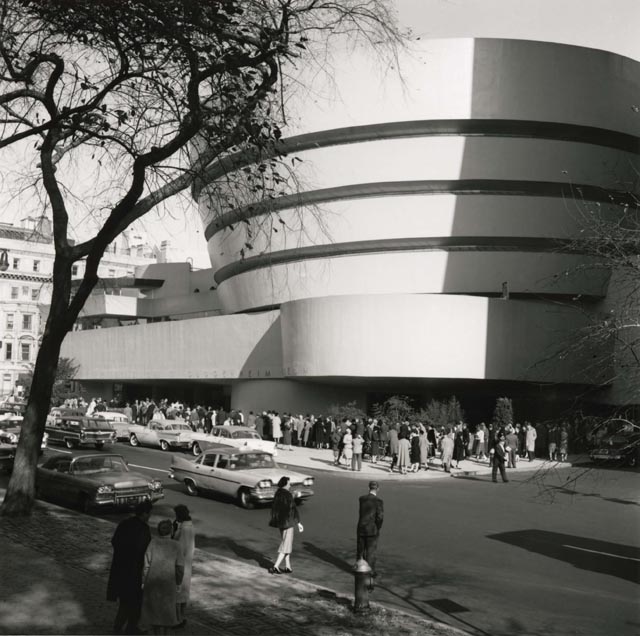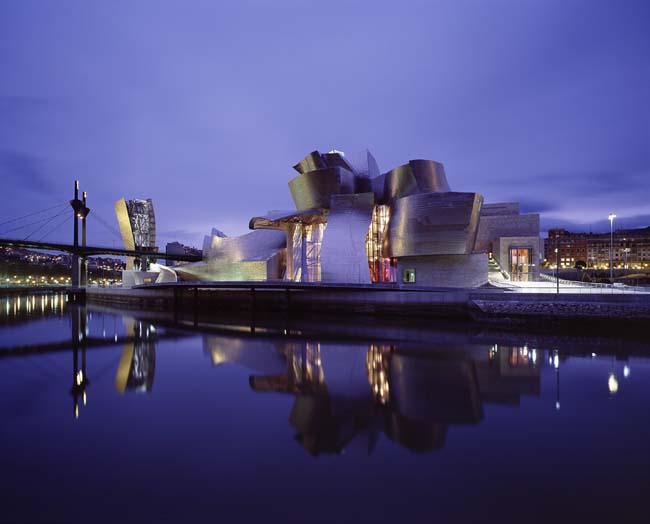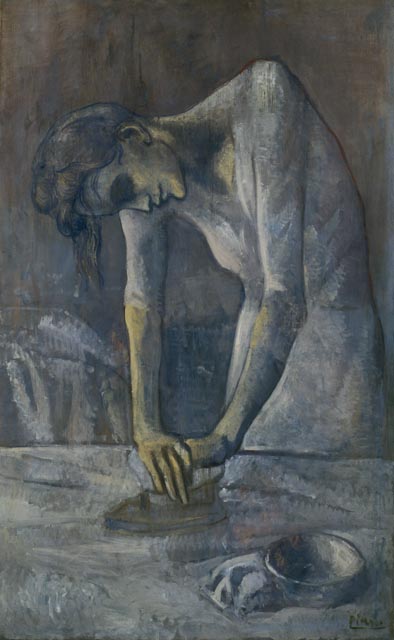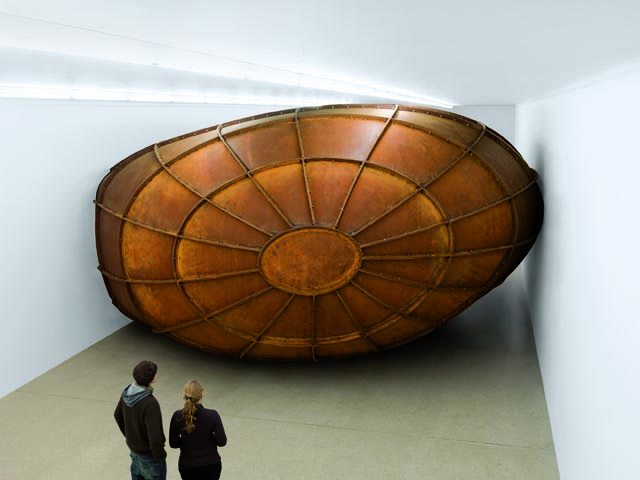
This futuristic icon, embedded on Fifth Avenue, has both a present and a past…
There are hundreds of people streaming around a circular, stunning white building on Fifth Avenue as cars and buses and taxis honk and inch their way on the traffic laden street. With a start you realize the men are all wearing suits and hats, the women prim dresses, even the children are dressed decorously in coat dresses – and the automobiles are all large, with chrome plating and flashy tail fins.
Indeed, this is a black and white video clip from 1959, on the cusp of the sixties. Today, in 2009, everything in this scene has changed – except the white edifice, which is still futuristic, still a building before its time.
Or perhaps it is timeless.
Welcome to the iconic Solomon R. Guggenheim Museum which celebrates its 50th anniversary this year and is still age-defying, creating a new grammar of design. Walk down Fifth Avenue where the Guggenheim stands, opposite Central Park, and you see the cars are transformed, the clothes of the people have changed. People are now dressed informally, casually and yet still fit naturally within this building which 50 years after its birth still looks au courant, perfect for the times.
This museum is the master creation of the architect Frank Lloyd Wright and it has influenced architects, designers, artists and dreamers over the years with its ground breaking idiom of design. “Crafted from within outward, his spaces provide refuge and prospect, uniting as one entity a building, its inhabitants, and the natural world,” says Phil Allsopp, President of the Frank Lloyd Wright Foundation.
‘Guggenheim’ is a big mouthful but the charming children’s book ‘I’d like the Goo-Gen-Heim’ by A.C. Hollingsworth breaks up this big word, and shows the museum as a smiling, welcoming building to all people. It is named after the philanthropist Solomon R. Guggenheim who with his wife Irene wanted to create a perfect environment for their eclectic modern and contemporary art collection.

The permanent collection is a rich treasure trove of nonobjective painting, abstract and Surrealist painting and sculpture. It includes Justin K. Thannhauser’s array of Impressionist, Post-Impressionist, and early modern masterpieces; and Count Giuseppe Panza di Biumo’s vast holdings of European and American Minimalist, Post-Minimalist, Environmental, and Conceptual art. Over the years these collections have been enriched by gifts from many sources, making it a layered and enriched collection dating from the 19th century to the present. (For a comprehensive look at the collections, check out www.guggenheim.org)
The Guggenheims’ vision has expanded to several museums bearing the Guggenheim name including the Peggy Guggenheim Collection in Venice. It also provides programming and management to the Guggenheim Museum Bilbao in Spain, and the Deutsche Guggenheim in Berlin. On the drawing board is the Guggenheim Abu Dhabi Museum in the United Arab Emirates. This 452,000 sq. foot museum is set to open in 2013. Designed by noted architect Frank Gehry, it will be the largest Guggenheim and will have global art with a focus on Middle Eastern contemporary art.
With nearly three million annual visitors worldwide, the Guggenheim and its network of museums is one of the most visited cultural institutions in the world. Since 1992 the Guggenheim has produced more than 275 exhibitions including such big ones as Kazimir Malevich: Suprematism, Africa: The Art of a Continent, The Aztec Empire, and China: 5000 Years. In fact many Guggenheim-organized exhibitions have shown in 80 museums around the world.

As Richard Armstrong, Director of the Guggenheim Foundation and Museum, notes about these rich cultural exchanges globally, “Our privilege lies in having access to myriad points of view, definitions of beauty, and venues for conversation and even controversy, and our responsibility is to use this stimulating mix of ideas as inspiration for intellectual and artistic growth and to create exhibitions that can be shared with visitors from around the world.”
And it all started with the very first venture in New York, with the commission to build a museum by Frank Lloyd Wright.
It took 16 years to construct the Guggenheim in New York and ironically Wright never lived to see his masterpiece – he died six months before it was completed. But his creation lives on, and has been designated a national historic landmark.
It is fitting that this 50th anniversary is marked by an exhibition ‘Frank Lloyd Wright – From Within Outward’, which examines Wright’s work over a span of 70 years and how it influenced modern life in so many aspects.
SO WHAT’S SO SPECIAL ABOUT THE GUGGENHEIM?
“Wright’s practice of urban design for a deep experience of community hinged on the permeability of boundaries, on a destabilizing enactment of new and multiple relations between things,” writes architect Mina Marefat.
Indeed, stand on any floor of this geometric masterpiece with its spiraling ramps which get larger and larger as you go upwards, and you see life, people, and movement on every level – the rush of humanity, like so many theatrical plays being enacted on so many different stages at the same time.
Standing on the top floor near the great dome you feel you are in a soaring cathedral, a temple dedicated to design. It is futuristic looking and yet so utilitarian in its function: built entirely of reinforced concrete, it incorporates seating areas in the same flowing concrete.
As the ‘From Within Outward’ catalog notes: ‘Floor, balcony edge and the outer wall are all woven together by steel and concrete. A further element to the significance of the ramp is that at any one place on it one is able to see where one was and at the same time, where one is going. In this sense, the ramp provides a sort of time-space continuum, a sort of ‘when past is future’. The very nature of the ramp itself suggests change and motion.”
The physical space serves as a canvas for the great art – each exhibition seems to be transformed by the surrounding architecture and there is drama in those circular passages, sheer poetry in their simplicity.

The museum is totally devoted to art and architecture, and education is a key element. Upcoming exhibitions include Kandinsky, which brings together 100 paintings of the artist from the Guggenheim, Lenbachhaus in Munich and the Pompidou in Paris.
Another major upcoming show is Anish Kapoor: Memory which is a site specific installation by the Asian-British artist Anish Kapoor. One can only anticipate how this 24 ton installation of Cor-Ten steel will look in the rotunda of the Guggenheim!
One of the upcoming exhibitions is of London-born, Berlin born artist Tino Sehgal, who has a German mother and Indian father. His startling work defies borders of what is art and what is not, pushing the envelope on the debate for it has no material aspects of traditional art making. His ‘constructed situations’ which only exist in the gestures and memories of participants will be featured in the dramatic undulating circles of the Guggenheim, continuing the debate.
Indeed, in 2010 the museum will host ‘Contemplating the Void: Interventions in the Guggenheim Museum Rotunda’ – an exhibition which celebrates the form and function of this spiraling space where artists have been challenged and inspired by the surroundings to create and invent.
One can almost imagine another video clip, 50 years later. Our clothes, our hair, our cars will look quaint, out-dated in 2058, but in the foreground of humanity’s mad dash on Fifth Avenue will stand the Guggenheim, still timeless, the quintessential icon of modernity in the global city of New York…
AT HOME IN THE WORLD
Asia is very much on the radar of Guggenheim, and in recent years many innovative initiatives have taken place. In 2006 the museum started an Asian Art Program with the appointment of Alexandra Munro, who was earlier with the Japan Society, as a senior curator of Asian art in the Guggenheim. She spearheaded a program which would integrate itself into the overall curatorial department, highlighting modern and contemporary art from Asia, on Asia and about Asia within the preexisting structures at the museum.

In the past three years several initiatives have been undertaken with that kind of over-reaching plan in mind, encompassing everything from exhibitions to public events and scholarship. In 2007 the museum appointed Sandhini Poddar, who is from Bombay, as the first Assistant Curator of Asian Art. She has MAs in Indian, Islamic East Asian art history and aesthetics from the University of Bombay and also a MA in Visual Arts Administration from New York University.
Since 2006 two major exhibitions have showcased the Asian connection: Cai Guo-Qiang: I Want to Believe was the first solo exhibition for a Chinese artist at the Guggenheim, and the show later traveled to Beijing and is now on view at the Bilbao Guggenheim.
The Third Mind: American Artists Contemplate Asia, 1860 to 1989 was another landmark exhibition which highlighted the Asian influences on the work of American artists. Says Poddar: “Very large historic sweep of late 19th through the 20th century – artists living in America who have really looked to Japan, India, and China, the literatures that they have, the metaphysics they embodied, the philosophies they created as source material for their own artistic expression.” This also included artists who happened to be of Asian origin who had contributed to American art history such as Indian-American artists Natvar Bhavsar and Zarina Hashmi.

Poddar curated a commission program with London based artist Anish Kapoor and this important breakthrough work called Memory, made of 24 tons of steel, was on view in the Deutsche Guggenheim in Berlin and will be showcased in New York this October, to coincide with the 50th anniversary of the Guggenheim.
“Over a period of time this will be accessioned into the permanent collection of the Guggenheim,” says Poddar. “So that’s one of the ways that the Guggenheim can engage with some really dynamic new work, and that propels the artist to do something that’s really experimental on their end and also quite important and monumental which can come into the collection finally.”
The Guggenheim has also acquired the work of Delhi-based sculptor and installation artist Susanta Madal through its Young Collectors Council which is geared toward emerging talent. Poddar predicts the acquisitions will pick up greater speed with the major initiative with Guggenheim in Abu Dhabi starting in 2013.
In the brave new global world, the Guggenheim is on the cutting edge, catering to different audiences in different spaces and different cultures with its presence in different countries. By including curators from varied cultural backgrounds, like Poddar, the Guggenheim is opening up the space to unique voices, and subsequently to multi-cultural artists who may not have been seen otherwise.
“The Guggenheim has always been an institution that has been very forward thinking, “says Poddar. “It distinguishes itself as an institution that really has a pulse on what’s happening with global culture internationally. It’s an institution which is willing to take risks and is willing to be the leader in the field.”
© Lavina Melwani

1 Comment
Wonderful article! I learned a few new things about one of my favorite museums! Thank you!